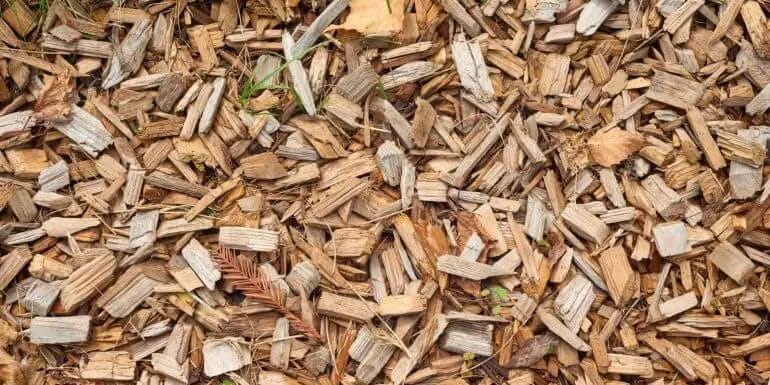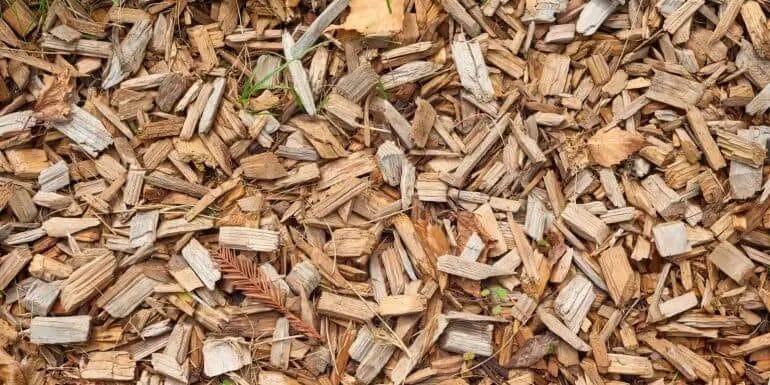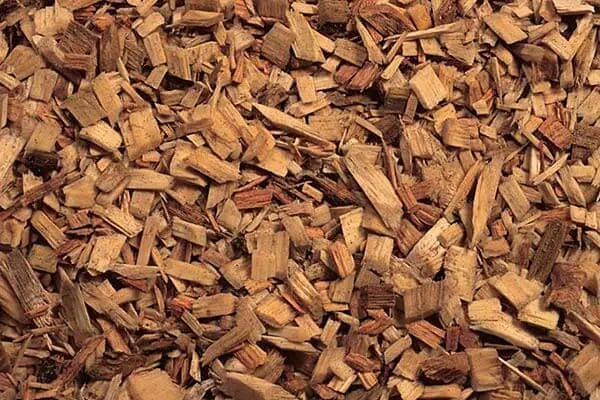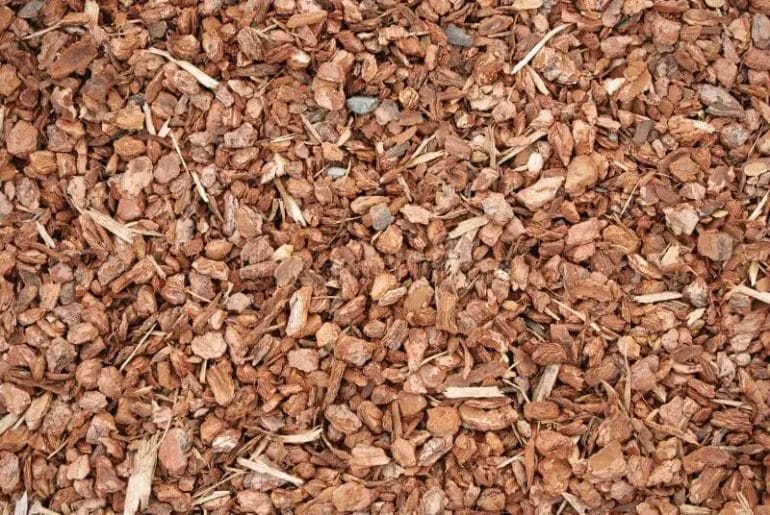Wood chips are versatile and widely used in various industries and applications.
One common use of wood chips is as a biomass fuel in power plants and heating systems, providing a renewable and sustainable energy source.

They also serve as an essential component in gardening and landscaping, helping to improve soil structure and retain moisture.
Wood chips are often utilized in the woodworking industry for creating particleboards, fiberboards, and paper products.
Furthermore, they are ideal for mulching pathways and flower beds, suppressing weeds, and enhancing the aesthetic appeal of outdoor spaces.

Wood Chips for Mulching: Improve soil health and conserve moisture with wood chips
Wood chips are an excellent option for mulching, as they not only enhance the aesthetic appeal of your garden but also provide numerous benefits for the soil and plants. Mulching with wood chips has gained popularity among gardeners and landscapers due to its ability to improve soil health and conserve moisture levels. In this section, we will explore the advantages of using wood chips as mulch and how they can contribute to the overall vitality of your garden.
1. Organic Matter and Nutrient Enrichment
One of the primary advantages of using wood chips for mulching is their ability to break down and add organic matter to the soil. As the wood chips decompose, they release essential nutrients into the soil, such as nitrogen, phosphorus, and potassium. These nutrients are vital for plant growth and development, promoting healthier foliage, stronger root systems, and increased resistance to pests and diseases.
By incorporating wood chips into your garden beds, you can steadily improve the nutrient content of the soil, creating a fertile environment for your plants to thrive. This natural method of nutrient enrichment reduces the need for synthetic fertilizers, making mulching with wood chips an eco-friendly choice.
2. Water Conservation
Another significant benefit of mulching with wood chips is their ability to conserve moisture in the soil. Wood chips act as a protective barrier, reducing evaporation and preventing water loss from the soil surface. This is especially advantageous in hot and dry climates, where water scarcity is a concern.
The layer of wood chips helps to regulate soil temperature, keeping it cooler during hot summer months and preventing rapid moisture evaporation. Additionally, wood chips allow water to penetrate the soil slowly, promoting deep root growth and reducing the frequency of watering. This not only saves water but also encourages drought-tolerant plants to thrive.
3. Weed Suppression
Weeds can be a nuisance in any garden, competing with your desired plants for nutrients, sunlight, and water. However, mulching with wood chips can significantly reduce weed growth and minimize the need for manual weeding or chemical herbicides.
When a layer of wood chips is applied to the soil surface, it acts as a physical barrier, preventing weed seeds from germinating and penetrating the soil. This effectively suppresses weed growth and saves you time and effort in maintaining a weed-free garden.
4. Soil Erosion Prevention
Wood chips can also play a crucial role in preventing soil erosion. The layer of mulch acts as a protective covering, preventing soil particles from being washed or blown away during heavy rainfall or strong winds.
By retaining the soil in place, wood chips help to maintain the overall structure and fertility of the soil. This is particularly beneficial on sloping landscapes or areas prone to erosion, as it helps to stabilize the soil and safeguard against potential damage.
5. Aesthetic Appeal
Lastly, wood chips can enhance the visual appeal of your garden by adding a natural and rustic touch to your landscaping. The varying textures and colors of wood chips can create an attractive contrast against the vibrant hues of your plants, making your garden more visually appealing.
Furthermore, wood chips provide a neat and uniform appearance to your garden beds, giving them a well-maintained and polished look. This can significantly improve the overall aesthetic value of your outdoor space.
In summary, mulching with wood chips offers numerous benefits for your garden. Not only do wood chips enrich the soil with organic matter and nutrients, but they also help conserve moisture, suppress weeds, prevent soil erosion, and enhance the overall appearance of your garden. Consider incorporating wood chips into your mulching routine to promote soil health, conserve water, and create a beautiful and thriving outdoor environment.

Wood Chips for Animal Bedding: Provide comfortable bedding for livestock and pets
Keeping livestock and pets comfortable and well-cared for is essential for their health and well-being. One often overlooked aspect of their environment is bedding. Providing high-quality bedding not only helps ensure their comfort but also contributes to their overall health and productivity. Wood chips are an excellent choice for animal bedding, offering numerous benefits for both livestock and pets.
1. Comfort and Insulation
Wood chips provide a soft and comfortable cushion for animals to rest and sleep on. Their natural texture and composition make them an ideal choice for bedding material. The chips create a padded surface that reduces pressure points, offering a more comfortable resting place for animals. Additionally, wood chips offer excellent insulation, keeping animals warm during colder seasons and providing a cooler surface during hot summer months.
2. Absorbency and Moisture Control
Wood chips have excellent absorbency properties, making them highly effective at controlling moisture in animal bedding. The chips can absorb and retain moisture, keeping the bedding dry and reducing the risk of bacterial growth and odors. This is particularly beneficial in livestock environments where animals produce large amounts of waste. By maintaining a dry bedding area, wood chips help promote a cleaner and healthier living space for animals.
3. Natural Odor Control
One common issue with animal bedding is the buildup of unpleasant odors. However, wood chips naturally contain aromatic compounds that help neutralize and control odors. These compounds act as natural deodorizers, creating a more pleasant and hygienic environment for both animals and their caretakers. With wood chips as bedding, the need for additional odor control methods is significantly reduced.
4. Dust and Allergen Reduction
Wood chips are generally low in dust, making them an excellent choice for animals with respiratory sensitivities or allergies. The reduced dust levels help improve air quality and minimize the risk of respiratory issues in both livestock and pets. By choosing wood chips for animal bedding, you can create a healthier and more comfortable environment for your animals.
5. Cost-Effective and Sustainable
In addition to their many benefits, wood chips are also a cost-effective and sustainable option for animal bedding. They are often readily available and reasonably priced compared to other bedding materials. Wood chips can also be sourced from sustainable forestry practices, making them an environmentally friendly choice. By using wood chips, you can provide high-quality bedding for your animals while minimizing your environmental impact.
When it comes to providing bedding for your livestock or pets, wood chips are an excellent choice. They offer comfort, insulation, absorbency, natural odor control, dust reduction, and are cost-effective and sustainable. By choosing wood chips as bedding material, you can ensure the well-being and comfort of your animals, contributing to their overall health and productivity.

Wood Chips for Biomass Energy: Utilize wood chips as a renewable energy source
In recent years, there has been a growing interest in utilizing renewable energy sources to reduce greenhouse gas emissions and combat climate change. One such source that has gained attention is wood chips for biomass energy. This article will explore the use of wood chips as a renewable energy source and its potential benefits.
1. What are wood chips?
Wood chips are small pieces or chunks of wood that are typically derived from various wood materials such as branches, logs, or wood waste. These chips can be produced through a process called chipping, where the wood is cut into smaller pieces using specialized machinery.
2. How are wood chips used for biomass energy?
Wood chips can be used as a feedstock for biomass energy production. Biomass energy refers to the use of organic matter, such as wood, for the generation of heat or electricity. Wood chips are burned in specialized biomass boilers or furnaces to produce steam, which can then be used to generate electricity or heat for various applications.
3. Benefits of utilizing wood chips as a renewable energy source
There are several advantages to utilizing wood chips for biomass energy:
- Renewable and Sustainable: Wood chips come from renewable sources, such as sustainably managed forests, making them a sustainable energy option.
- Reduced Carbon Emissions: Biomass energy derived from wood chips has lower carbon emissions compared to fossil fuels like coal or natural gas, contributing to a cleaner environment.
- Local Economic Benefits: The production and use of wood chips for biomass energy can create local job opportunities and support the growth of the forestry and wood processing industries.
- Waste Reduction: Utilizing wood chips as a biomass energy source can help in reducing wood waste that would otherwise be sent to landfills.
- Energy Independence: By using wood chips for energy production, countries can reduce their reliance on imported fossil fuels and achieve greater energy independence.
4. Challenges and considerations
While wood chips for biomass energy offer numerous benefits, there are also challenges and considerations that need to be taken into account:
- Supply and Demand: Ensuring a consistent and adequate supply of wood chips can be a challenge, especially in regions with high demand for biomass energy.
- Transportation and Storage: Wood chips need to be transported and stored properly, which requires proper logistics and infrastructure.
- Efficiency and Technology: Continuous advancements in biomass energy technologies and efficiency improvements are necessary to maximize the energy output from wood chips.
- Environmental Impact: While biomass energy is considered renewable, the harvesting and production processes may still have environmental implications that need to be managed.
5. Conclusion
In summary, wood chips offer a promising renewable energy source in the form of biomass energy. Their utilization can contribute to reducing carbon emissions, promoting local economic growth, and reducing waste. However, challenges such as supply and demand, transportation, and environmental impacts must be carefully addressed. With ongoing advancements in technology and sustainable forestry practices, wood chips have the potential to play a significant role in the transition towards a cleaner and more sustainable energy future.
Wood Chips for Smoking Food
Enhance the flavor of your culinary creations with the delightful smoky taste that wood chips provide. Whether you’re a professional chef or an amateur grilling enthusiast, using wood chips for smoking can take your dishes to a whole new level. The smoky aroma and complex flavors imparted by the wood chips can transform an ordinary meal into a culinary masterpiece.
Why Use Wood Chips?
Wood chips are an excellent choice for smoking food due to their versatility and variety. Different types of wood chips offer distinct flavors that can complement a wide range of dishes. From subtle and sweet to bold and robust, there is a wood chip flavor for every palate and culinary creation.
One of the main advantages of using wood chips for smoking is the ability to infuse your food with natural, aromatic flavors. Unlike liquid smoke or artificial additives, wood chips provide an authentic and genuine smoky taste that can’t be replicated. They bring out the best in your meats, vegetables, and even cheeses, giving them a unique and unforgettable flavor profile.
Choosing the Right Wood Chips
When it comes to selecting wood chips for smoking, it’s important to consider the type of food you’re preparing and the flavor profile you want to achieve. Different woods offer different flavors, and pairing the right wood chips with your ingredients can elevate your culinary creations.
Here are some popular types of wood chips and their flavor profiles:
- Hickory: Known for its strong, robust flavor, hickory wood chips are perfect for smoking red meats, such as beef and pork.
- Mesquite: Mesquite wood chips are renowned for their intense and earthy flavor, making them ideal for grilling or smoking bold-flavored meats like lamb or game.
- Apple: If you prefer a sweeter and milder smoke flavor, apple wood chips are an excellent choice. They work well with poultry, fish, and even vegetables.
- Cherry: Cherry wood chips offer a subtly sweet and fruity flavor that pairs beautifully with pork, poultry, and even desserts.
These are just a few examples, and there are numerous other wood chip options available, each with its unique characteristics and flavor profiles. Experimenting with different wood chips can be an exciting journey of discovering new taste combinations and enhancing your culinary skills.
Using Wood Chips for Smoking
Once you have chosen the perfect wood chips for your dish, it’s time to start smoking. Here are some tips to help you achieve the best results:
- Soak the wood chips in water for about 30 minutes before using them. This will prevent them from burning too quickly and ensure a steady release of smoke.
- Place the soaked wood chips in a smoker box, aluminum foil pouch, or directly on the hot coals, depending on the type of grill or smoker you’re using.
- Preheat your grill or smoker to the desired temperature before adding the wood chips.
- Once the wood chips start smoking, carefully place your food on the grill or smoker and close the lid to trap the smoke.
- Monitor the temperature and cooking time to ensure your food is cooked to perfection.
Remember, smoking food is an art that requires patience and practice. Don’t be afraid to experiment with different wood chip flavors and cooking techniques to find your signature smoky masterpiece.
In summary, wood chips are an incredible tool for adding smoky flavors to your culinary creations. They offer a wide range of flavor options, allowing you to customize your dishes to suit your preferences. Whether you’re grilling, smoking, or barbecuing, the enticing aroma and rich taste of wood-smoked food will leave a lasting impression on your taste buds. So why wait? Elevate your cooking skills and indulge in the wonderful world of wood-chip smoking.
FAQs
What are wood chips used for?
Wood chips have a variety of uses, including landscaping, gardening, and animal bedding. They can be used as a decorative ground cover, mulch, or to create pathways in gardens. Wood chips are also commonly used for fuel in biomass energy production.
Conclusion
In conclusion, wood chips are versatile and have a wide range of uses. They are commonly used as a natural and sustainable landscaping material, providing benefits such as weed suppression, moisture retention, and soil enrichment. Wood chips are also utilized for animal bedding in farms and as a renewable energy source in biomass power plants. Additionally, they can be used in composting to accelerate the decomposition process and create nutrient-rich soil amendments. With their eco-friendly properties and various applications, wood chips are an excellent choice for organic gardening, sustainable farming, and eco-conscious energy production.